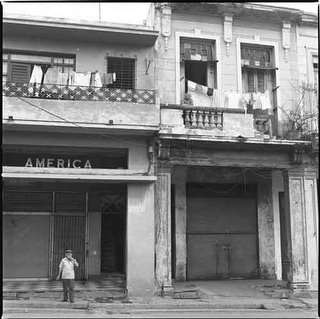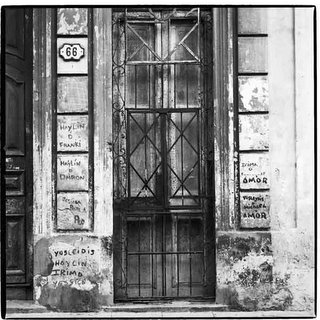 This old door with all the grafitti appealed to me. All the boys'and girls'names made me want to call it "El Puerto de l'amore." But, I wasn't sure of the Spanish, so I passed on that. I realized this morning that I had been lax in posting pictures, so I am cranked back up. I have been busy upgrading my web site, so check that out if time permits.
This old door with all the grafitti appealed to me. All the boys'and girls'names made me want to call it "El Puerto de l'amore." But, I wasn't sure of the Spanish, so I passed on that. I realized this morning that I had been lax in posting pictures, so I am cranked back up. I have been busy upgrading my web site, so check that out if time permits.
On the street in Havana you hear the young people greet each other with the phrase, "Que Bola?" this is equivalent to our US slang phrase "What's up?" This Cuba photo blog is morphing into my general blog with a wider scope of photos and commentary.This will enable me to keep my website clean and still have space to babble.
Tuesday, February 28, 2006
Old door
 This old door with all the grafitti appealed to me. All the boys'and girls'names made me want to call it "El Puerto de l'amore." But, I wasn't sure of the Spanish, so I passed on that. I realized this morning that I had been lax in posting pictures, so I am cranked back up. I have been busy upgrading my web site, so check that out if time permits.
This old door with all the grafitti appealed to me. All the boys'and girls'names made me want to call it "El Puerto de l'amore." But, I wasn't sure of the Spanish, so I passed on that. I realized this morning that I had been lax in posting pictures, so I am cranked back up. I have been busy upgrading my web site, so check that out if time permits.
Saturday, February 25, 2006
Che Tees
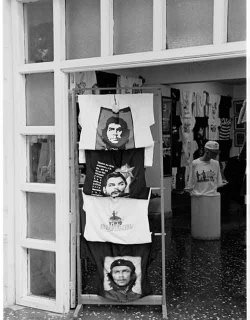 Che tee shirts are encountered the world over. There are many images of him all over Cuba. Clearly he and Mao are the two most famous revolutionaries in recent history. Che was made a martyr, probably intentionally, and has proved more useful to the revolution dead than he was alive. An intellectual, a hardcore revolutionary, a husband and father, he had no qualms about killing those who stood in the way of the revolutionary movement. It is unusual to see young Cubans wearing Che tee shirts. They do turn up at parades and rallies, but that is about it. Most of the tees are on sale to tourists. It is hilarious to see older bulky tourists in their Che Guevara berets.
Che tee shirts are encountered the world over. There are many images of him all over Cuba. Clearly he and Mao are the two most famous revolutionaries in recent history. Che was made a martyr, probably intentionally, and has proved more useful to the revolution dead than he was alive. An intellectual, a hardcore revolutionary, a husband and father, he had no qualms about killing those who stood in the way of the revolutionary movement. It is unusual to see young Cubans wearing Che tee shirts. They do turn up at parades and rallies, but that is about it. Most of the tees are on sale to tourists. It is hilarious to see older bulky tourists in their Che Guevara berets.
Friday, February 24, 2006
Chapel in Bauta
 This lovely small chapel was being cleaned by these two ladies. I wanted to take their picture, but they insisted that they must finish, put up their mops and buckets before any photos were made. There was a very nice replica of a ship, perhaps Noah's Ark, in the vestibule of the chapel. There are churches and chapels throughout Cuba. There are at least two synagogues in Havana. I have been to church (Episcopal) in Havana, there were perhaps 300-350 people there, no one seemed the least bit intimidated or nervous. All of the rumors about the suppression of the church and possession of bibles or the persecution of church going people is just not the case. It might have been years ago, but certainly since the visit of Pope John in 1998 things have changed.
This lovely small chapel was being cleaned by these two ladies. I wanted to take their picture, but they insisted that they must finish, put up their mops and buckets before any photos were made. There was a very nice replica of a ship, perhaps Noah's Ark, in the vestibule of the chapel. There are churches and chapels throughout Cuba. There are at least two synagogues in Havana. I have been to church (Episcopal) in Havana, there were perhaps 300-350 people there, no one seemed the least bit intimidated or nervous. All of the rumors about the suppression of the church and possession of bibles or the persecution of church going people is just not the case. It might have been years ago, but certainly since the visit of Pope John in 1998 things have changed.
Thursday, February 23, 2006
Checking the news in Vinales
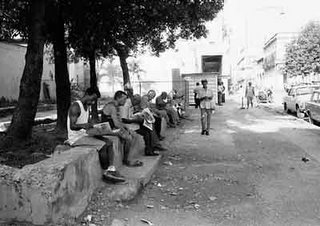 The morning paper is dutifully read, and it is one of the ways of communicating the latest antics of the government to the people. The main paper, Granma, named for the boat that brought the revolutionaries back from Mexico, is the leading goverment journal. It is typically about eight pages, costs fifty cents for tourists and a couple of pesos to the local people. These fellows are spending a lazy, hot summer afternoon, hanging out and reading the paper. Hanging out seems to be one of the major pastimes and avocations amongst the people.
The morning paper is dutifully read, and it is one of the ways of communicating the latest antics of the government to the people. The main paper, Granma, named for the boat that brought the revolutionaries back from Mexico, is the leading goverment journal. It is typically about eight pages, costs fifty cents for tourists and a couple of pesos to the local people. These fellows are spending a lazy, hot summer afternoon, hanging out and reading the paper. Hanging out seems to be one of the major pastimes and avocations amongst the people.
Wednesday, February 22, 2006
A Song for La Caridad del Cobre

The white girls lift their heads like trees
The black girls go
Reflected like flamingoes in the street.
The white girls sing as shrill as water,
The black girls talk as quiet as clay.
The white girls open their arms like clouds,
The black girls close their eyes like wings:
Angels bow down like bells,
Angels look up like toys.
Because the heavenly stars
Stand in a ring:
And all the pieces of the mosaic, earth,
Get up and fly away like birds.
------The Seven Storey Mountain, Thomas Merton, 1948
Monday, February 20, 2006
Millenium
 I made this photo in the year 2000. I liked the name of the store. This was a major store in a major shopping area. There were what had once been nice shops and boutiques along the street. They were all now empty and closed, or barely open as peso stores. Over the past five years, the area has made a slight come back as more tourist hotels have opened nearby, and there are actually a few shoppers. The department store remains closed and in disrepair. It is not unreasonable that this has happened. Most of the elites and the upper middle class Cubans departed early in the history of the revolution. As the people from the country side moved into the city, they had to learn how to finction in the city. By the time they were educated and ready for assimilation into society, they had been indoctrinated into the great middling effect of revolutionary thinking. The 1900s were in fact a final century for a way of life in Cuba. Things have changed for the better and the worse, but they will never return to the way they were in the last mid-century.
I made this photo in the year 2000. I liked the name of the store. This was a major store in a major shopping area. There were what had once been nice shops and boutiques along the street. They were all now empty and closed, or barely open as peso stores. Over the past five years, the area has made a slight come back as more tourist hotels have opened nearby, and there are actually a few shoppers. The department store remains closed and in disrepair. It is not unreasonable that this has happened. Most of the elites and the upper middle class Cubans departed early in the history of the revolution. As the people from the country side moved into the city, they had to learn how to finction in the city. By the time they were educated and ready for assimilation into society, they had been indoctrinated into the great middling effect of revolutionary thinking. The 1900s were in fact a final century for a way of life in Cuba. Things have changed for the better and the worse, but they will never return to the way they were in the last mid-century.
Sunday, February 19, 2006
America
Saturday, February 18, 2006
Morning Traffic in Trinidad
 Trinidad hums in the morning. People are out on the street walking, visiting, having their coffee. There are a lot of these sidecar/motor cycles in use. They were imported by the Russians and many remain functional, especially out in the country side. This city has had a fair amount of restoration, the entire place having been declared a"World Heritage Center". It is friendly, almost too much so. The advent of tourists coming by the bus loads has promoted the growth of jineteros, hustlers, who offer lodging, meals, cigars, rum, and other delights to the tourist. The jineteros are mainly middle men, or agents, rarely is there any vilient crime. There is a growing amount of petty crime- purses, cameras, small handbags and backpacks being snatched-as there is in every tourist area in the world, third or otherwise.
Trinidad hums in the morning. People are out on the street walking, visiting, having their coffee. There are a lot of these sidecar/motor cycles in use. They were imported by the Russians and many remain functional, especially out in the country side. This city has had a fair amount of restoration, the entire place having been declared a"World Heritage Center". It is friendly, almost too much so. The advent of tourists coming by the bus loads has promoted the growth of jineteros, hustlers, who offer lodging, meals, cigars, rum, and other delights to the tourist. The jineteros are mainly middle men, or agents, rarely is there any vilient crime. There is a growing amount of petty crime- purses, cameras, small handbags and backpacks being snatched-as there is in every tourist area in the world, third or otherwise.
Friday, February 17, 2006
Macheteros
 The term "companero" is generally regarded much like "comrade" in the soviet era. These guys are really macheteros. They are getting the sugar cane they have cut weighed. It is mindboggling to see the old antiquated equipment and ox drawn wagons that are still being used in the small sugar industry that persists in Cuba. This timeless scene was photographed on the road to Viñales. This is hot, back breaking manual labor that only a few still perform. The zafra or sugar harvest has been the topic of both books and movies. The last time I was at Centrale Australia, the sugar refinery at the turn from the main highway toward Playa Giron, the were dismantling the large plant. I tried to take some pictures, but was chased away by a couple of security guards. When asked why I couldn't make some photos, they answered "It's part of the economy, top secret." I accepted that as part of the natural Cuban paranoia. It never occurred to me that they might have WMDs hidden in there.
The term "companero" is generally regarded much like "comrade" in the soviet era. These guys are really macheteros. They are getting the sugar cane they have cut weighed. It is mindboggling to see the old antiquated equipment and ox drawn wagons that are still being used in the small sugar industry that persists in Cuba. This timeless scene was photographed on the road to Viñales. This is hot, back breaking manual labor that only a few still perform. The zafra or sugar harvest has been the topic of both books and movies. The last time I was at Centrale Australia, the sugar refinery at the turn from the main highway toward Playa Giron, the were dismantling the large plant. I tried to take some pictures, but was chased away by a couple of security guards. When asked why I couldn't make some photos, they answered "It's part of the economy, top secret." I accepted that as part of the natural Cuban paranoia. It never occurred to me that they might have WMDs hidden in there.
Thursday, February 16, 2006
Bahia Habana
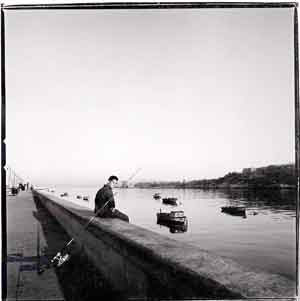 In the early morning it is pleasant to walk along the Bahia Habaña enjoying the fresh, cool air. The only people out early are the fishermen. There are plenty of fish to be caught, but I would not eat them. In spite of its beauty, the bahia is one of the ten dirtiest bays in the world. The little wooden fishing boats bob along the edge, they are all quite colorful and create a quaint scene. Across the street and a small park, the artists and craftspeople are setting up their booths for another day of the Feria des Artisanas. There is a gentle hubbub of conversation, things being hammered together, and people showing up for another day. Some fish, some sell their wares, some just hang out.
In the early morning it is pleasant to walk along the Bahia Habaña enjoying the fresh, cool air. The only people out early are the fishermen. There are plenty of fish to be caught, but I would not eat them. In spite of its beauty, the bahia is one of the ten dirtiest bays in the world. The little wooden fishing boats bob along the edge, they are all quite colorful and create a quaint scene. Across the street and a small park, the artists and craftspeople are setting up their booths for another day of the Feria des Artisanas. There is a gentle hubbub of conversation, things being hammered together, and people showing up for another day. Some fish, some sell their wares, some just hang out.
Monday, February 13, 2006
Produce stand
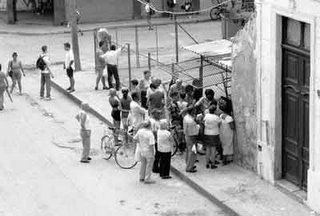 When the average Cuban awakens in the morning, there are three problems to be faced . These are breakfast, lunch, and supper. There is definitley no epidemic of obesity on the island. This photo is of a produce stand, a government owned and run business that has something different each day over the week. People queue up there each day until it is sold out. Early each morning a truck comes from who knows where and unloads its cargo. The sound of this attracts the people in the neighborhood who roll out to get their daily ration of mangoes, potatos, yucca, grain or whatever is there that day. There is rarely enought to go around, so being there early is a good move. The tourist hotels and restaurants get the better quality food and have enough to provide excellent meals for their guests. At the house where I stay, the propietor leaves in the morning and returns several hours later with several sacks full of food. I don't ask whwere it comes from. It is good.
When the average Cuban awakens in the morning, there are three problems to be faced . These are breakfast, lunch, and supper. There is definitley no epidemic of obesity on the island. This photo is of a produce stand, a government owned and run business that has something different each day over the week. People queue up there each day until it is sold out. Early each morning a truck comes from who knows where and unloads its cargo. The sound of this attracts the people in the neighborhood who roll out to get their daily ration of mangoes, potatos, yucca, grain or whatever is there that day. There is rarely enought to go around, so being there early is a good move. The tourist hotels and restaurants get the better quality food and have enough to provide excellent meals for their guests. At the house where I stay, the propietor leaves in the morning and returns several hours later with several sacks full of food. I don't ask whwere it comes from. It is good.
Saturday, February 11, 2006
In Trinidad one morning
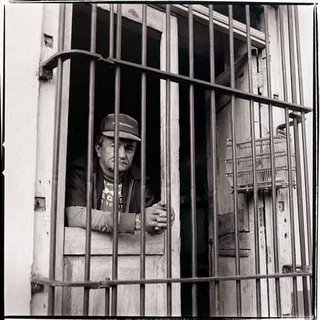 I was out for a walk early one morning. I encountered lots of people who were in their windows so to speak. They were surveying the morning scene, talking to whomever might pass by. I liked this picture of the man behind his bars, being sort of caged in similar to his pet bird. Birds in cages are favorite pets in Trinidad. One sometimes sees them being carried over to a neighbors so the owners can go to work, sometimes people will carry them to work rather than leave them at home. Trinidad is a friendly place, very beautiful, and has a nice beach close by.
I was out for a walk early one morning. I encountered lots of people who were in their windows so to speak. They were surveying the morning scene, talking to whomever might pass by. I liked this picture of the man behind his bars, being sort of caged in similar to his pet bird. Birds in cages are favorite pets in Trinidad. One sometimes sees them being carried over to a neighbors so the owners can go to work, sometimes people will carry them to work rather than leave them at home. Trinidad is a friendly place, very beautiful, and has a nice beach close by.
Friday, February 10, 2006
Front Porch II
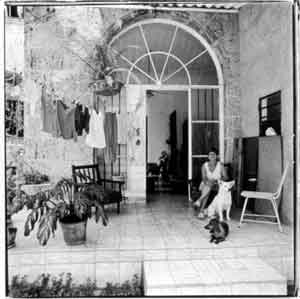 Some front porches are more elegant like this one on Linea up in Vedado. This lady occupies the front apartment. This lovely old mansion which at one time likely had more servants than owners has been subdivided into multiple apartments. These apartments were then rented for nominal sums to "the people". After paying rent for 7 years, the house becomes yours. Most of the stately old homes are in terrible disrepair, some are crumbling, others have been reasonably well kept. Like anywhere, it depends on the occupants. Most of the apartments are nicer than the bohios and frame houses one encounters in the countryside. Most of these homes were the property of those displaced by the revolution.
Some front porches are more elegant like this one on Linea up in Vedado. This lady occupies the front apartment. This lovely old mansion which at one time likely had more servants than owners has been subdivided into multiple apartments. These apartments were then rented for nominal sums to "the people". After paying rent for 7 years, the house becomes yours. Most of the stately old homes are in terrible disrepair, some are crumbling, others have been reasonably well kept. Like anywhere, it depends on the occupants. Most of the apartments are nicer than the bohios and frame houses one encounters in the countryside. Most of these homes were the property of those displaced by the revolution.
Thursday, February 09, 2006
Front Porch
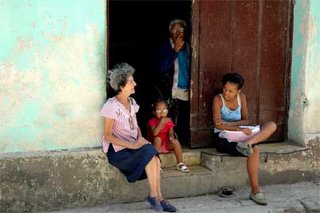 For many families, the front porch is really just the threshhold to their front door, or maybe simply the curb on the street. Children play, mothers and grandmothers visit, hang out, and spend their time in the doorways. As seen here another tradition is that multiple generations all live together, it is typically three, occasionally four generations, in a house or apartment. I have noticed that it seems here in the US that people are much closer in the more traditional ethnic neighborhoods. In progressive generations as they move to more diversified and upscale areas be it in the burbs or in the cities, the closeness and the family ties lessen. I am not at all sure that that is a good thing. Maybe it takes some hardship to bring people closer together.
For many families, the front porch is really just the threshhold to their front door, or maybe simply the curb on the street. Children play, mothers and grandmothers visit, hang out, and spend their time in the doorways. As seen here another tradition is that multiple generations all live together, it is typically three, occasionally four generations, in a house or apartment. I have noticed that it seems here in the US that people are much closer in the more traditional ethnic neighborhoods. In progressive generations as they move to more diversified and upscale areas be it in the burbs or in the cities, the closeness and the family ties lessen. I am not at all sure that that is a good thing. Maybe it takes some hardship to bring people closer together.
Tuesday, February 07, 2006
Coconut Palms
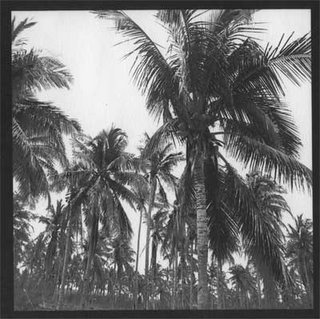 This is a palladium print of palm trees out in the country side near Cienfuegoes. These are coconut palms, not the stately and more beautiful Royal Palms. There is a lot of open land in Cuba, and many undeveloped areas remain in their natural state. There are also many areas that are returning to the state of being un-used. This can be seen especially in the Valle de Indigenes where sugar production has declined to almost nothing. In spite of this, the tropical landscape is gorgeous and inviting.
This is a palladium print of palm trees out in the country side near Cienfuegoes. These are coconut palms, not the stately and more beautiful Royal Palms. There is a lot of open land in Cuba, and many undeveloped areas remain in their natural state. There are also many areas that are returning to the state of being un-used. This can be seen especially in the Valle de Indigenes where sugar production has declined to almost nothing. In spite of this, the tropical landscape is gorgeous and inviting.
Monday, February 06, 2006
CocoTaxi
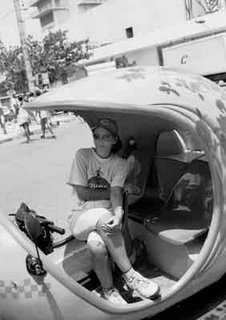 These are the best form of transportation in Havana. The drivers are all young, personable, and atractive. Unless there is a driving rain it is comfortable in the shell sitting back and taking in the passing view. Several times during each workshop trip, we would call for 4 or 5 of these contraptions to take us to our destination. All the students enjoyed the ride. The CocoTaxis are intended for the tourists as compared with the bicitaxis which are pretty much a Cuban designated means of transport. Great fun!
These are the best form of transportation in Havana. The drivers are all young, personable, and atractive. Unless there is a driving rain it is comfortable in the shell sitting back and taking in the passing view. Several times during each workshop trip, we would call for 4 or 5 of these contraptions to take us to our destination. All the students enjoyed the ride. The CocoTaxis are intended for the tourists as compared with the bicitaxis which are pretty much a Cuban designated means of transport. Great fun!
Sunday, February 05, 2006
53 Buick
 The old automobiles add to the "frozen in time" feeling of being in Cuba. The government has definitely accomplished the difficult feat of making time stand still. In the past few years many of the old cars were confiscated and turned into taxis so that tourists could enjoy their ride in a "classic." This was to the detriment of the owners of the old cars who once under the "taxi particulars" system owned their cars, could haul people, and charge for it. Everytime someone figures out a new scheme to make a little money the government comes along and imposes heavy taxes, takes over the service or business, or simply removes that particular occuaption from the list of things approved for people to participate in and develop their own business.
The old automobiles add to the "frozen in time" feeling of being in Cuba. The government has definitely accomplished the difficult feat of making time stand still. In the past few years many of the old cars were confiscated and turned into taxis so that tourists could enjoy their ride in a "classic." This was to the detriment of the owners of the old cars who once under the "taxi particulars" system owned their cars, could haul people, and charge for it. Everytime someone figures out a new scheme to make a little money the government comes along and imposes heavy taxes, takes over the service or business, or simply removes that particular occuaption from the list of things approved for people to participate in and develop their own business.
Friday, February 03, 2006
More dominos
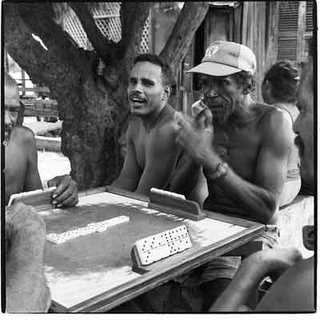 These are the opposition to the photo posted below. This was a highly animated game. It is decidedly different from the chess matches that also are prevalent in the parks, streets, and outside the doors of homes. It is abundantly clear that there is not a lot of work going on in many of these neighborhoods. I guess that is the lot of many third world countries. This way of passing time is not the province of old men, it involves young ones as well. Bound to be unsatisfying to young, educated men who simply can't find a job. Most of them are anxious to talk about life in the US and they are interested in learning about places other than Miami. Questions like "can you get a better job in Detroit than in Miami?" are common.
These are the opposition to the photo posted below. This was a highly animated game. It is decidedly different from the chess matches that also are prevalent in the parks, streets, and outside the doors of homes. It is abundantly clear that there is not a lot of work going on in many of these neighborhoods. I guess that is the lot of many third world countries. This way of passing time is not the province of old men, it involves young ones as well. Bound to be unsatisfying to young, educated men who simply can't find a job. Most of them are anxious to talk about life in the US and they are interested in learning about places other than Miami. Questions like "can you get a better job in Detroit than in Miami?" are common.
Thursday, February 02, 2006
Bicitaxi outside CDR
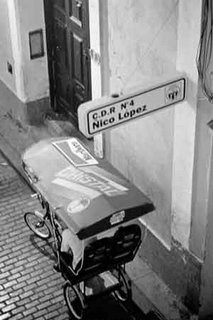 The bicitaxi is a bicycle-rickshaw sort of contraption that is the cheapest people hauler in Havana. They have been pretty much relegated to transportation for locals in the peso economy. The past two times I have ridden in a bicitaxi, we have been stopped by the police and the driver was issued a citation for hauling tourists. The goal is to push the tourists into a more expensive form of transport. This is one of the oft cited "CDRs". Nico Lopez was a printer, a black man, who was a revolutionary. This photo was made from the window in my room across the street. I never saw anything going on in the CDR except frequent games of dominos. It was interesting that once we had a group of students living in the house, a policeman was at each end of our block for the first week we were there. They were quite helpful with directions and seemed to enjoy talking to the female students. Since all were well behaved young people, there were no problems.
The bicitaxi is a bicycle-rickshaw sort of contraption that is the cheapest people hauler in Havana. They have been pretty much relegated to transportation for locals in the peso economy. The past two times I have ridden in a bicitaxi, we have been stopped by the police and the driver was issued a citation for hauling tourists. The goal is to push the tourists into a more expensive form of transport. This is one of the oft cited "CDRs". Nico Lopez was a printer, a black man, who was a revolutionary. This photo was made from the window in my room across the street. I never saw anything going on in the CDR except frequent games of dominos. It was interesting that once we had a group of students living in the house, a policeman was at each end of our block for the first week we were there. They were quite helpful with directions and seemed to enjoy talking to the female students. Since all were well behaved young people, there were no problems.
Wednesday, February 01, 2006
Royal Palms at Capitolio
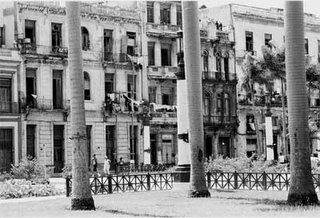 Royal Palms abound in Cuba. They are planted all over the grounds of the Capitolio where this photo was made. I like to go there and pick a spot and just stay in that one place and let the photos come to me. There is always lots of action in this part of Havana. This is where the major avenues and what were once some of the most glorious shopping districts in North America all came together as a bustling crossroads. This is where many of the grand old hotels are. Some have been restored, others are just sad shells of past glory. Either way there are lots of people out and about, laughter and shouts , music, auto horns, and the bells of the bicitaxis all fill the air. Several of the cigar factories are nearby, it's still a happening place.
Royal Palms abound in Cuba. They are planted all over the grounds of the Capitolio where this photo was made. I like to go there and pick a spot and just stay in that one place and let the photos come to me. There is always lots of action in this part of Havana. This is where the major avenues and what were once some of the most glorious shopping districts in North America all came together as a bustling crossroads. This is where many of the grand old hotels are. Some have been restored, others are just sad shells of past glory. Either way there are lots of people out and about, laughter and shouts , music, auto horns, and the bells of the bicitaxis all fill the air. Several of the cigar factories are nearby, it's still a happening place.
Subscribe to:
Posts (Atom)
